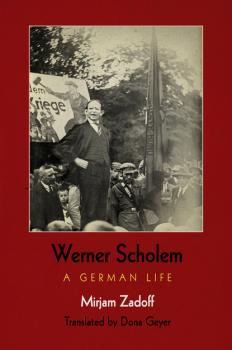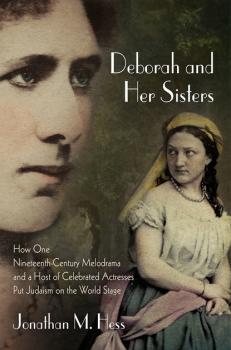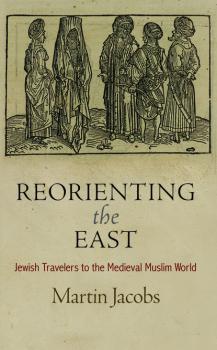Jewish Culture and Contexts
Скачать книги из серии Jewish Culture and ContextsConnecting Histories
Whether forced by governmental decree, driven by persecution and economic distress, or seeking financial opportunity, the Jews of early modern Europe were extraordinarily mobile, experiencing both displacement and integration into new cultural, legal, and political settings. This, in turn, led to unprecedented modes of social mixing for Jews, especially for those living in urban areas, who frequently encountered Jews from different ethnic backgrounds and cultural orientations. Additionally, Jews formed social, economic, and intellectual bonds with mixed populations of Christians. While not necessarily effacing Jewish loyalties to local places, authorities, and customs, these connections and exposures to novel cultural settings created new allegiances as well as new challenges, resulting in constructive relations in some cases and provoking strife and controversy in others. The essays collected by Francesca Bregoli and David B. Ruderman in Connecting Histories show that while it is not possible to speak of a single, cohesive transregional Jewish culture in the early modern period, Jews experienced pockets of supra-local connections between West and East—for example, between Italy and Poland, Poland and the Holy Land, and western and eastern Ashkenaz—as well as increased exchanges between high and low culture. Special attention is devoted to the impact of the printing press and the strategies of representation and self-representation through which Jews forged connections in a world where their status as a tolerated minority was ambiguous and in constant need of renegotiation. Exploring the ways in which early modern Jews related to Jews from different backgrounds and to the non-Jews around them, Connecting Histories emphasizes not only the challenging nature and impact of these encounters but also the ambivalence experienced by Jews as they met their others. Contributors : Michela Andreatta, Francesca Bregoli, Joseph Davis, Jesús de Prado Plumed, Andrea Gondos, Rachel L. Greenblatt, Gershon David Hundert, Fabrizio Lelli, Moshe Idel, Debra Kaplan, Lucia Raspe, David B. Ruderman, Pavel Sládek, Claude B. Stuczynski, Rebekka Voß.
Werner Scholem
Werner Scholem never took the easy path. Born in 1895 into the Berlin Jewish middle class, he married a young non-Jewish woman of proletarian background. He was the youngest member of the Prussian Parliament in the 1920s, one of the leaders of the German Communist Party, and the editor of the influential journal The Red Flag . As an outspoken critic of Stalin, he was soon expelled from the party, only to take up a position at the head of a revolutionary Trotskyite faction in the years before 1933. Reviled by the National Socialists as a Communist and a Jew, he was among the first to be arrested when Hitler rose to power and, after a long incarceration, was murdered in Buchenwald. In Werner Scholem: A German Life Mirjam Zadoff has written a book that is at once a biography of an individual, a family chronicle, and the story of an entire era. It is an account of the ruptures within a society and of the growing insecurity in which German Jews lived between the two world wars—and especially of two brothers who chose opposing paths out of the shared conviction that there was no future for Jews in Germany after the First World War. While Werner pinned his hopes on a universal revolution he would never see, the younger Gerhard emigrated to Palestine where, as Gershom, he would choose revolutionary Zionism and the reanimation of ancient strains of Jewish mysticism.
Deborah and Her Sisters
Before Fiddler on the Roof , before The Jazz Singer , there was Deborah , a tear-jerking melodrama about a Jewish woman forsaken by her non-Jewish lover. Within a few years of its 1849 debut in Hamburg, the play was seen on stages across Germany and Austria, as well as throughout Europe, the British Empire, and North America. The German-Jewish elite complained that the playwright, Jewish writer S. H. Mosenthal, had written a drama bearing little authentic Jewish content, while literary critics protested that the play lacked the formal coherence of great tragedy. Yet despite its lackluster critical reception, Deborah became a blockbuster, giving millions of theatergoers the pleasures of sympathizing with an exotic Jewish woman. It spawned adaptations with titles from Leah, the Forsaken to Naomi, the Deserted , burlesques, poems, operas in Italian and Czech, musical selections for voice and piano, a British novel fraudulently marketed in the United States as the original basis for the play, three American silent films, and thousands of souvenir photographs of leading actresses from Adelaide Ristori to Sarah Bernhardt in character as Mosenthal's forsaken Jewess. For a sixty-year period, Deborah and its many offshoots provided audiences with the ultimate feel-good experience of tearful sympathy and liberal universalism. With Deborah and Her Sisters , Jonathan M. Hess offers the first comprehensive history of this transnational phenomenon, focusing on its unique ability to bring Jews and non-Jews together during a period of increasing antisemitism. Paying careful attention to local performances and the dynamics of transnational exchange, Hess asks that we take seriously the feelings this commercially successful drama provoked as it drove its diverse audiences to tears. Following a vast paper trail in theater archives and in the press, Deborah and Her Sisters reconstructs the allure that Jewishness held in nineteenth-century popular culture and explores how the Deborah sensation generated a liberal culture of compassion with Jewish suffering that extended beyond the theater walls.
Entangled Histories
From Halakhic innovation to blood libels, from the establishment of new mendicant orders to the institutionalization of Islamicate bureaucracy, and from the development of the inquisitorial process to the rise of yeshivas, universities, and madrasas, the long thirteenth century saw a profusion of political, cultural, and intellectual changes in Europe and the Mediterranean basin. These were informed by, and in turn informed, the religious communities from which they arose. In city streets and government buildings, Jews, Christians, and Muslims lived, worked, and disputed with one another, sharing and shaping their respective cultures in the process. The interaction born of these relationships between minority and majority cultures, from love and friendship to hostility and violence, can be described as a complex and irreducible «entanglement.» The contributors to Entangled Histories: Knowledge, Authority, and Jewish Culture in the Thirteenth Century argue that this admixture of persecution and cooperation was at the foundation of Jewish experience in the Middle Ages. The thirteen essays are organized into three major sections, focusing in turn on the exchanges among intellectual communities, on the interactions between secular and religious authorities, and on the transmission of texts and ideas across geographical, linguistic, and cultural boundaries. Rather than trying to resolve the complexities of entanglement, contributors seek to outline their contours and explain how they endured. In the process, they examine relationships not only among Jewish, Christian, and Muslim communities but also between communities within Judaism—those living under Christian rule and those living under Muslim rule, and between the Jews of southern and northern Europe. The resulting volume develops a multifaceted account of Jewish life in Europe and the Mediterranean basin at a time when economic, cultural, and intellectual exchange coincided with heightened interfaith animosity. Contributors : Elisheva Baumgarten, Piero Capelli, Mordechai Z. Cohen, Judah Galinsky, Elisabeth Hollender, Kati Ihnat, Ephraim Kanarfogel, Katelyn Mesler, Ruth Mazo Karras, Sarah J. Pearce, Rami Reiner, Yossef Schwartz, Uri Shachar, Rebecca Winer, Luke Yarbrough.
Purchasing Power
How has the ability of Jews to amass and wield power, within both Jewish and non-Jewish society, influenced and been influenced by their economic activity? Purchasing Power answers this question by examining the nexus between money and power in modern Jewish history. It does so, in its first section, by presenting a series of case studies of the ways in which the economic choices made by Jewish businessmen could bring them wealth and influence. The second section focuses on transnational Jewish philanthropic and economic networks. The discussions there reveal how the wielding of power by Jewish organizations on the world stage could shape not only Jewish society but also the international arena. In this way, the contributors to this volume reposition economics as central to our understanding of the Jewish experience from early modern Rome to contemporary America. Its importance for the creation of the State of Israel is also examined. As the editors write: «The study of culture and identity has proved valuable and enlightening (and, in some senses, also comfortable) in understanding the complexities of Jewish history. Perhaps we should now return to the issues of the material bases for Jewish life, and the ways in which Jews have exploited them in their search for wealth and power. Our understanding of the Jewish past will be immeasurably enriched in the effort.» Contributors: Cornelia Aust, Bernard Cooperman, Veerle Vanden Daelen, Jonathan Dekel-Chen, Glenn Dynner, Abigail Green, Jonathan Karp, Rebecca Kobrin, Adam D. Mendelsohn, Derek Penslar, Adam Sutcliffe, Adam Teller, Carsten L. Wilke.
Secularism in Question
For much of the twentieth century, most religious and secular Jewish thinkers believed that they were witnessing a steady, ongoing movement toward secularization. Toward the end of the century, however, as scholars and pundits began to speak of the global resurgence of religion, the normalization of secularism could no longer be considered inevitable. Recent decades have seen the strengthening of Orthodox movements in the United States and in Israel; religious Zionism has grown and radically changed since the 1960s, and new and vibrant nondenominational Jewish movements have emerged. Secularism in Question examines the ways these contemporary revivals of religion prompt a reconsideration of many issues concerning Jews and Judaism from the early modern era to the present. Bringing together scholars of history, religion, philosophy, and literature, this volume illustrates how the categories of «religious» and «secular» have frequently proven far more permeable than fixed. The contributors challenge the problematic assumptions about the development of secularism that emerge from Protestant European and American perspectives and demonstrate that global Jewish experiences necessitate a reappraisal of conventional narratives of secularism. Ultimately, Secularism in Question calls for rethinking the very terms that animate many of the most contentious debates in contemporary Jewish life and far beyond. Contributors: Michal Ben-Horin, Aryeh Edrei, Jonathan Mark Gribetz, Ari Joskowicz, Ethan B. Katz, Eva Lezzi, Vivian Liska, Rachel Manekin, David Myers, Amnon Raz-Krakotzkin, Andrea Schatz, Christophe Schulte, Daniel B. Schwartz, Galili Shahar, Scott Ury.
Reorienting the East
Reorienting the East explores the Islamic world as it was encountered, envisioned, and elaborated by Jewish travelers from the Middle Ages to the early modern period. The first comprehensive investigation of Jewish travel writing from this era, this study engages with questions raised by postcolonial studies and contributes to the debate over the nature and history of Orientalism as defined by Edward Said. Examining two dozen Hebrew and Judeo-Arabic travel accounts from the mid-twelfth to the early sixteenth centuries, Martin Jacobs asks whether Jewish travelers shared Western perceptions of the Islamic world with their Christian counterparts. Most Jews who detailed their journeys during this period hailed from Christian lands and many sailed to the Eastern Mediterranean aboard Christian-owned vessels. Yet Jacobs finds that their descriptions of the Near East subvert or reorient a decidedly Christian vision of the region. The accounts from the crusader era, in particular, are often critical of the Christian church and present glowing portraits of Muslim-Jewish relations. By contrast, some of the later travelers discussed in the book express condescending attitudes toward Islam, Muslims, and Near Eastern Jews. Placing shifting perspectives on the Muslim world in their historical, social, and literary contexts, Jacobs interprets these texts as mirrors of changing Jewish self-perceptions. As he argues, the travel accounts echo the various ways in which premodern Jews negotiated their mingled identities, which were neither exclusively Western nor entirely Eastern.
Next Year in Marienbad
From the last decades of the nineteenth century through the late 1930s, the West Bohemian spa towns of Carlsbad, Franzensbad, and Marienbad were fashionable destinations for visitors wishing to «take a cure»—to drink the waters, bathe in the mud, be treated by the latest X-ray, light, or gas therapies, or simply enjoy the respite afforded by elegant parks and comfortable lodgings. These were sociable and urbane places, settings for celebrity sightings, match-making, and stylish promenading. Originally the haunt of aristocrats, the spa towns came to be the favored summer resorts for the emerging bourgeoisie. Among the many who traveled there, a very high proportion were Jewish. In Next Year in Marienbad , Mirjam Zadoff writes the social and cultural history of Carlsbad, Franzensbad, and Marienbad as Jewish spaces. Secular and religious Jews from diverse national, cultural, and social backgrounds mingled in idyllic and often apolitical-seeming surroundings. During the season, shops sold Yiddish and Hebrew newspapers, kosher kitchens were opened, and theatrical presentations, concerts, and public readings catered to the Jewish clientele. Yet these same resorts were situated in a region of growing hostile nationalisms, and they were towns that might turn virulently anti-Semitic in the off season. Next Year in Marienbad draws from memoirs and letters, newspapers and maps, novels and postcards to create a compelling and engaging portrait of Jewish presence and cultural production in the years between the fin de siècle and the Second World War.
The Hebrew Book in Early Modern Italy
The rise of printing had major effects on culture and society in the early modern period, and the presence of this new technology—and the relatively rapid embrace of it among early modern Jews—certainly had an effect on many aspects of Jewish culture. One major change that print seems to have brought to the Jewish communities of Christian Europe, particularly in Italy, was greater interaction between Jews and Christians in the production and dissemination of books. Starting in the early sixteenth century, the locus of production for Jewish books in many places in Italy was in Christian-owned print shops, with Jews and Christians collaborating on the editorial and technical processes of book production. As this Jewish-Christian collaboration often took place under conditions of control by Christians (for example, the involvement of Christian typesetters and printers, expurgation and censorship of Hebrew texts, and state control of Hebrew printing), its study opens up an important set of questions about the role that Christians played in shaping Jewish culture. Presenting new research by an international group of scholars, this book represents a step toward a fuller understanding of Jewish book history. Individual essays focus on a range of issues related to the production and dissemination of Hebrew books as well as their audiences. Topics include the activities of scribes and printers, the creation of new types of literature and the transformation of canonical works in the era of print, the external and internal censorship of Hebrew books, and the reading interests of Jews. An introduction summarizes the state of scholarship in the field and offers an overview of the transition from manuscript to print in this period.
Modern Jewish Literatures
Is there such a thing as a distinctive Jewish literature? While definitions have been offered, none has been universally accepted. Modern Jewish literature lacks the basic markers of national literatures: it has neither a common geography nor a shared language—though works in Hebrew or Yiddish are almost certainly included—and the field is so diverse that it cannot be contained within the bounds of one literary category. Each of the fifteen essays collected in Modern Jewish Literatures takes on the above question by describing a movement across boundaries—between languages, cultures, genres, or spaces. Works in Hebrew and Yiddish are amply represented, but works in English, French, German, Italian, Ladino, and Russian are also considered. Topics range from the poetry of the Israeli nationalist Natan Alterman to the Russian poet Osip Mandelstam; from turn-of-the-century Ottoman Jewish journalism to wire-recorded Holocaust testimonies; from the intellectual salons of late eighteenth-century Berlin to the shelves of a Jewish bookstore in twentieth-century Los Angeles. The literary world described in Modern Jewish Literatures is demarcated chronologically by the Enlightenment, the Haskalah, and the French Revolution, on one end, and the fiftieth anniversary of the State of Israel on the other. The particular terms of the encounter between a Jewish past and present for modern Jews has varied greatly, by continent, country, or village, by language, and by social standing, among other things. What unites the subjects of these studies is not a common ethnic, religious, or cultural history but rather a shared endeavor to use literary production and writing in general as the laboratory in which to explore and represent Jewish experience in the modern world.









